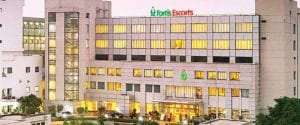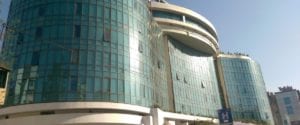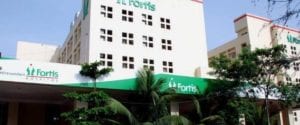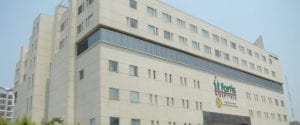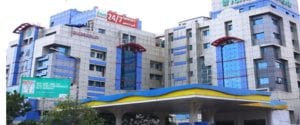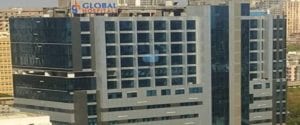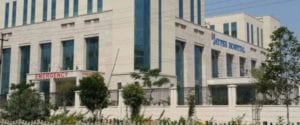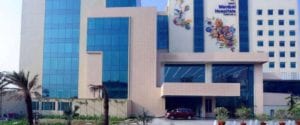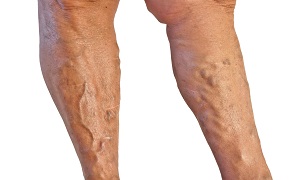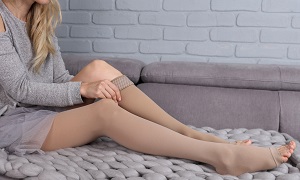Best Sclerotherapy Doctors in India
Best Sclerotherapy Hospitals in India
Fortis Escorts Hospital, New Delhi
- City: New Delhi, India
Hospital Highlights:
- Over the last 33 years, the Fortis Escorts Heart Institute has set new standards in cardiac treatment with groundbreaking research. It is now known around the world as a centre of expertise for Cardiac Bypass Surgery, Interventional Cardiology, Non-invasive Cardiology, Paediatric Cardiology, and Paediatric Cardiac Surgery.
- The hospital has cutting-edge laboratories that perform a wide range of diagnostic tests in Nuclear Medicine, Radiology, Biochemistry, Haematology, Transfusion Medicine, and Microbiology.
- Fortis Escorts Heart Institute boasts a diverse group of bright and experienced doctors who are backed up by a team of highly qualified, experienced, and devoted support professionals as well as cutting-edge equipment such as the recently installed Dual CT Scan.
- Approximately 200 cardiac doctors and 1600 personnel currently collaborate to manage over 14,500 admissions and 7,200 emergency situations each year. The hospital now has a 310-bed infrastructure, as well as five cath labs and a slew of other world-class amenities.
Rela Hospital, Chennai
- City: Chennai, India
Hospital Highlights:
- RIMC is a multi-specialty hospital in a sprawling area of 36 acres located in Chromepet, Chennai, Tamil Nadu, India.
- The facility has 450 beds including 130 critical care beds, 9 operating rooms, modern reference laboratories and radiology services, and is conveniently located near road, rail and air transportation.
- RIMC is led and managed by world-renowned physicians committed to healthcare.
- RIMC offers the broadest range of clinical care, education, and research. The hospital offers state-of-the-art technology and modern treatment facilities designed to provide health care at an affordable cost.
- Rela Institute is driven by patient needs, comfort and confidence.
CARE Hospitals, Hyderabad
- City: Hyderabad, India
Hospital Highlights:
- CARE Hospitals were established in the year 2000, by CARE Group.
- The multispecialty hospital has 435 beds, including 120 critical care beds, with an annual inflow of 180000 outpatients and 16,000 in-patients.
- The hospital provides specialty medical services in Cardiology, Cardiothoracic Surgery, Pediatric Cardiology, Pediatric Cardiothoracic Surgery, Neurology, Neurosurgery, Nephrology, and Urology.
- The hospital has the first dual source, 128 slice CT scanner (for high precision cardiac imaging) – the first of its kind in south India.
- The hospital offers a wide range of accommodation facilities for the convenience of its varied patient base, ranging from general wards to super deluxe rooms.
Fortis Hiranandani Hospital, Mumbai
- City: Mumbai, India
Hospital Highlights:
- Fortis Hiranandani hospital was established in 2007.
- The hospital is an advanced tertiary care, multi-specialty hospital equipped with 149 beds.
- The hospital is equipped with a super ICU to provide emergency medical care to critically ill patients.
- The hospital is NABH accredited.
- The critical care facility in the hospital is augmented with the state-of-the-art facilities that facilitate speedier diagnosis and efficient monitoring.
- The hospital provides specialty medical services in cardiology, orthopedic science, pediatric science, neurology, diabetic care, urology, nephrology, ENT, obstetrics, gynecology, cosmetic surgery, bariatric surgery, neuro and spine care.
Fortis Hospital, Anandpur, Kolkata
- City: Kolkata, India
Hospital Highlights:
- Fortis Hospital, Anandapur, Kolkata is a world-class super-speciality equipped with the latest technologies in the medical world.
- The hospital is NABH accredited.
- This state-of-the-art facility specializes in cardiology and cardiac surgery, urology, nephrology, neurosciences, orthopaedics, digestive care, emergency care and critical care.
- The hospital, governed by integrated Building Management System (IBMS), has a pneumatic chute system, for quick vertical and horizontal transportation between floors, facilitating speedy transfer of patient specimens, documents, reports, and medicines to the concerned departments.
- The hospital also has a nephrology department with over 28 advanced dialysis units.
Fortis Hospital Banerghatta, Bengaluru
- City: Bengaluru, India
Hospital Highlights:
- Fortis Hospital Bannerghatta, Bengaluru was established in 2006.
- The hospital is a 276 bedded multi-specialty tertiary care facility.
- The hospital specializes in cutting-edge medical technology and dedicated patient care services.
- The hospital is equipped with state-of-the-art technologies like trans-radial angioplasty, trans-abdominal cardiac surgery, and computerized TKR navigation surgery.
- The hospital provides specialty medical services in cardiology, cardiac surgery, orthopedics, neurology, neuro-surgery, GI, and Minimal Access Surgery (MAS).
Fortis Hospital, Malar, Chennai
- City: Chennai, India
Hospital Highlights:
- Fortis Malar was established in 1992 and was formerly known as Malar Hospital.
- The hospital specializes in cutting-edge medical technology and dedicated patient care services.
- The hospital is multi-specialty, tertiary care facility with 180 beds.
- The hospital offers comprehensive medical care in specialties such as cardiology, cardio-thoracic surgery, neurology, neurosurgery, orthopedics, nephrology, gynecology, gastroenterology, urology, pediatrics, and diabetes.
Gleneagles Global Hospital, Parel, Mumbai
- City: Mumbai, India
Hospital Highlights:
- Gleneagles Global Hospital The 450-bed facility comprises of 17-stories, housing state-of-the-art infrastructure, and advanced medical care facilities.
- The hospital offers end-to-end clinical, surgical, and diagnostic services. It is equipped with a team of eminent medical professionals aided by qualified nurses and medical staff
- The Hospital offers advanced Endoscopic procedures, Hepatobiliary and Liver Surgeries, Surgical and Medical Gastroenterology, Bariatric Surgery, and Robotic surgery.
- The hospital is a center of excellence for Orthopedics, Joint Replacement, Knee Replacement, and Hip Replacement surgery.
Jaypee Hospital, Noida
- City: Noida, India
Hospital Highlights:
- Jaypee Hospital is the flagship hospital of the Jaypee Group.
- This hospital has commissioned 525 beds in the first phase and has been planned and designed as a 1200 bedded multi-specialty facility.
- It holds the accreditation of the NABH and NABL.
- The hospital has state-of-the-art infrastructure equipped with the latest technologies and modern equipment like 64 Slice PET CT, Dual Head 6 Slice SPECT CT, Gamma Camera, and Da Vinci Robotic Surgery for comprehensive robotic surgical solutions.
- It has special Centers dedicated to the major specialties to provide hassle-free and high-quality clinical care.
Manipal Hospital, Dwarka, Delhi
- City: New Delhi, India
Hospital Highlights:
- Manipal Hospitals, Dwarka, is a super-specialty hospital in Dwarka, New Delhi, which is a part of Manipal Hospitals Group.
- The hospital aims to provide the best treatment on par with international standards at a fraction of the cost.
- Equipped with 380 beds, the hospital is also one of the new age hospitals which are equipped fully with state-of-the-art infrastructure, cutting-edge technology as well as the latest and advanced clinical practices. The hospital also has 13 modular Operation theatres with 118 beds which are solely meant for critical care.
- The hospital comprises internationally acclaimed doctors and highly professional and experienced hospital and medical staff who are able to provide preventive, therapeutic, and diagnostic services all under one roof.
Sclerotherapy
Sclerotherapy is a minimally invasive procedure for treating varicose veins and spider veins. Varicose veins are known to cause itching, pain, cramping as well as discoloration. Spider veins are smaller and compared to varicose veins, they are less severe.
In addition to diminishing the appearance of varicose or spider veins, the procedure also helps to reduce pain or side effects that are caused by damaged veins. Although anyone can get varicose veins, they are more common in men than women.
After sclerotherapy is performed, the treated veins usually fade within a few weeks. Although, occasionally, seeing full results might require a month or two.
Purpose
Sclerotherapy can be done for cosmetic procedures to improve the appearance of the varicose and spider veins. It can also be done to improve symptoms related to these conditions. These symptoms can include aching, swelling, burning, night cramps, etc.
It is important to note that if done for cosmetic reasons, then the cost may not be covered by your insurance.
Preparation
Before the procedure, your doctor will perform a physical exam as well as ask you about your medical history. The physical exam will involve evaluating the involved veins or checking for any underlying blood vessel disease.
You might also need to stop taking medications, such as aspirin or blood thinners, as they can increase the chances of bleeding.
Depending on which of your veins are involved, your doctor might be requesting ultrasound imaging on the veins in your legs. Ultrasound is a painless procedure which can produce images of structures inside your body with the use of sound waves.
On the day before the procedure, do not shave and avoid applying any lotion to your legs. You need to avoid shaving and applying lotion even after the procedure until the injection site is healed. Remember to wear loose and comfortable clothing. It is better if you wear a pair of shorts so that your legs are exposed.
Procedure
Generally, sclerotherapy is performed in a doctor’s office and it doesn’t require the use of anesthesia. It requires less than an hour to complete.
Depending on how severe your condition is, the treatment should take anywhere between 15 minutes to an hour. If you are getting the treatment on your legs, you might be required to lie on your back with your legs elevated.
Depending on how far below the skin the vein is, an ultrasound might be needed as part of your procedure.
Your doctor will clean the skin around the targeted veins. Then with a fine needle, the damaged veins will be injected with a sclerosing agent. The liquid or foam solution will cause the walls of the injected vein to seal shut. Therefore, blood is then redirected to unaffected veins. Over some time, your body will be absorbing the damaged vein, making it less visible and uncomfortable.
You might require up to four treatments based on the size of the treated veins.
After the procedure
You will be able to get up and walk around after the procedure is complete. It is important to walk and move your legs to prevent the formation of blood clots.
You might be asked to wear compression stocking or bandages, for around two weeks, as they can help maintain compression on the treated veins.
Although most people return to their normal routine, it might be wise to have someone drive you home after your procedure. Your doctor might also advise you to avoid any kind of strenuous exercise for a minimum of two weeks after the procedure.
It is also important to avoid sun exposure to the treated areas during this time. The inflammation caused by the injections can lead to dark spots on your skin if it is exposed to the sun. This is more likely if you have a dark skin tone.
Results
Smaller varicose veins and spider veins generally respond quite well to sclerotherapy. You should be able to see improvement within just a few weeks. For larger varicose veins, to see any improvement, it can take up to four months.
In some cases, several sessions of the treatment might be required for eliminating all the varicose or spider veins.
Before you undergo the procedure, it is also important to have realistic expectations about the effectiveness of the treatment. It doesn’t guarantee that there will be no traces of side effects of varicose or spider veins after you undergo the procedure.
Risks
In some cases, sclerotherapy can lead to a few serious complications. Some of the side effects that might occur at the site of the injection include bruising, raised red areas, small skin sores, multiple tiny red blood vessels and darkened skin in the form of lines or spots.
Though most of these side effects should generally go away within a few days or weeks, in a few cases, some side effects might take months or even years to completely disappear.
There might be few other complications as well, although these are less common. They include:
- Inflammation- Usually, this is mild but may sometimes cause swelling, warmth, and discomfort around the injection site. Your doctor may suggest an over-the-counter pain reliever to reduce the inflammation.
- Blood clot- A lump of clotted blood can form in a treated vein. In rare cases, a blood clot may even travel to a deeper vein in your leg. This is known as deep vein thrombosis, which is an emergency situation, where the clot travels from your leg to your lungs and blocks a vital artery. It is important to seek immediate care, if you experience any difficulty in breathing, chest pain, or dizziness or if you cough up blood.
- Air bubbles- Tiny air bubbles may rise in your bloodstream and although they don’t always cause symptoms, in some cases, they might. Symptoms can include visual disturbances, fainting, headaches, and nausea. These symptoms can go away generally, but it is important to call your doctor if you experience problems with limb movement or sensation after your procedure.
- Allergic reaction- Sometimes you might also develop an allergic reaction to the solution used for treatment, although this is uncommon.

